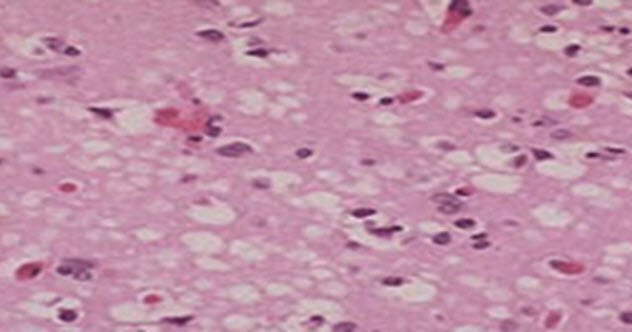 Weird Stuff
Weird Stuff  Weird Stuff
Weird Stuff  Our World
Our World 10 Ways Your Christmas Tree Is More Lit Than You Think
 Movies and TV
Movies and TV The 10 Coolest Stars to Set Sail on The Love Boat
 History
History 10 Things You Didn’t Know About the American National Anthem
 Technology
Technology Top 10 Everyday Tech Buzzwords That Hide a Darker Past
 Humans
Humans 10 Everyday Human Behaviors That Are Actually Survival Instincts
 Animals
Animals 10 Animals That Humiliated and Harmed Historical Leaders
 History
History 10 Most Influential Protests in Modern History
 Creepy
Creepy 10 More Representations of Death from Myth, Legend, and Folktale
 Technology
Technology 10 Scientific Breakthroughs of 2025 That’ll Change Everything
 Weird Stuff
Weird Stuff Ten Bizarre Facts About The Doge Meme
 Our World
Our World 10 Ways Your Christmas Tree Is More Lit Than You Think
 Movies and TV
Movies and TV The 10 Coolest Stars to Set Sail on The Love Boat
Who's Behind Listverse?

Jamie Frater
Head Editor
Jamie founded Listverse due to an insatiable desire to share fascinating, obscure, and bizarre facts. He has been a guest speaker on numerous national radio and television stations and is a five time published author.
More About Us History
History 10 Things You Didn’t Know About the American National Anthem
 Technology
Technology Top 10 Everyday Tech Buzzwords That Hide a Darker Past
 Humans
Humans 10 Everyday Human Behaviors That Are Actually Survival Instincts
 Animals
Animals 10 Animals That Humiliated and Harmed Historical Leaders
 History
History 10 Most Influential Protests in Modern History
 Creepy
Creepy 10 More Representations of Death from Myth, Legend, and Folktale
 Technology
Technology 10 Scientific Breakthroughs of 2025 That’ll Change Everything
10 Horrifying Facts About The Human Form Of Mad Cow Disease
Known as the human form of mad cow disease, variant Creutzfeldt-Jakob disease (vCJD) is an incredibly rare yet terrifying illness. Scientists currently do not know as much as they would like to about this condition.
But what they have discovered is fascinating and has led to increased health regulations for cattle meat production. For example, the US Department of Agriculture requires that all materials from the spinal cord and brain be eliminated from high-risk cattle. These products are not permitted in the US food supply.
Nevertheless, the facts about the human version of mad cow disease are truly horrifying.
10 It Is A Prion Disease

Prion diseases (aka transmissible spongiform encephalopathies) are rare forms of brain disorders which alter the structure of a patient’s brain and can be transmitted from one organism to another. Prion diseases can be found in both humans and animals, and vCJD is one of the deadliest human forms of prion disease.
All humans have prion proteins in our brains, but the normal function of these proteins is not yet fully understood by scientists. In vCJD, these normal prion proteins are affected by a diseased prion that is transmitted into the victim.
The infected prion will attach itself to the victim’s prion proteins and bend them into an abnormal shape. These newly infected prions will destroy brain cells and create gaps in brain tissue that cause the brain to resemble a sponge. As more prion proteins become infected, the victim will experience brain damage and other psychiatric symptoms.[1]
9 It Is Transferred Directly From Cows

The way in which humans obtain the abnormal prion that causes vCJD is almost always from eating the meat of a cow with bovine spongiform encephalopathy (aka mad cow disease or BSE). Mad cow disease is similar to vCJD because BSE is caused by an abnormal prion being transferred to the cattle.
It is not clear how mad cow began, but it is believed that it started with a cow consuming cattle feed that contained the meat of a sheep infected with scrapie (another prion disease). Scientists agree that mad cow originally spread in the UK when the meat of infected cattle was fed to young calves. Researchers have confirmed the relationship between these two diseases since the first cases of vCJD were reported in the UK, the same place where mad cow began.
UK citizens were most likely to be exposed to infected meat between 1984–86, and the first reported cases of vCJD were between 1994–96. This makes sense because the average incubation period of the diseased prion in both cows and humans is about 10 years.[2]
In some rare cases, a person has contracted vCJD from getting a blood transfusion from someone who has vCJD. But it is far more often caused by the meat of cattle infected with mad cow disease.
8 It Is A Form of A Larger Disease

vCJD is only one form of the more general disease known as Creutzfeldt-Jakob disease (CJD), which is defined as a disease caused by an infectious transferable prion. CJD is narrowed down into four specific diseases as each one has the prion being transferred to the human a different way. One of these specific forms of CJD is vCJD, and the other three forms are the same except for the way the prion is passed to the victim.
Sporadic Creutzfeldt-Jakob disease (sCJD) is the most common form of CJD, but it is also the most mysterious. In sCJD, one of the normal prion proteins in the victim’s brain changes spontaneously into an infected one. Scientists do not fully understand the cause of sCJD, but they believe it is more common in people with a specific version of the prion protein gene.
The third form is familial CJD, which is caused when a child inherits a gene abnormality that produces misshapen proteins. The symptoms of this disease usually do not begin until age 50, so parents with the mutated gene may not know they have it when they choose to start a family.
The last form of CJD is called iatrogenic CJD, and it is incredibly rare. This form transfers the diseased prion when a medical instrument that was used on someone with vCJD is not properly cleaned and is then used on another person.[3]
With all four of these terrifying diseases under the umbrella of CJD, many scientists have called Creutzfeldt-Jakob one of the most devastating brain disorders in existence.
7 It Created Another Disease

Kuru is another terrifying prion disease that spread through the tribal areas of Papua New Guinea. The disease was found in tribes that practiced a form of cannibalism where they ate the brains of their dead relatives as a mark of respect.
The tribes stopped this practice in the early 1960s, but cases of kuru continued because the disease has a long incubation period (at least 10 years). Interestingly, what happens in the brain of a person with kuru is similar to that of someone with vCJD as it causes a similar misshaped prion to begin infecting the brain’s proteins.
Scientists conducted research to determine why cannibalism caused a prion abnormality and came to a shocking hypothesis: Kuru originated from tribe members eating the brain of a person with Creutzfeldt-Jakob disease. Scientists confirmed this theory by comparing kuru prions with prions in all four forms of CJD and concluded that kuru prions have transmission properties very similar to those in CJD.
This means that a deceased member of a tribe in Papua New Guinea had CJD and nobody knew it. So they ate his brain and created a new form of prion disease. Scientists have not yet figured out what form of CJD the diseased tribe member had, but there is a high chance that it was vCJD.[4]
This is because there is an abundance of cattle in Papua New Guinea with very few health regulations or guidelines, which could have led to tribes consuming mad cow–infected cattle.
6 There Are No Viable Treatment Options

Unfortunately, there is no known cure for vCJD. A victim of this disease will sadly only survive an average of 13 months from the time of his first symptoms. Many drugs, such as amantadine and pentosan polysulphate, have been tested on vCJD victims, but none have proven to consistently help.
However, these medications have helped individual victims of this disease. In one reported case, a 22-year-old vCJD victim was treated with pentosan polysulphate (a drug meant to slow down the destruction of brain cells) and survived for 51 months after his first symptoms.
This is much higher than the 13-month average survival period, which means that this solution could work for more victims with further research. Currently, though, treatment is focused on keeping the patient comfortable and alleviating the symptoms of vCJD.[5]
5 It Causes Awful Psychiatric Symptoms

The symptoms of vCJD are mostly the same as the symptoms of the other forms of CJD. This happens because the abnormal prion is the same in every form, and the only difference among the forms is how they are transmitted.
As this diseased vCJD prion destroys the cells of a patient’s brain, it causes many symptoms related to the nervous system. First, a patient will experience problems with muscle coordination, such as involuntary muscle jerking and spasms.
As the brain deteriorates, the victim can experience numerous symptoms, such as hallucinations, forgetfulness, and, in some cases, blindness. Within a year after the first symptoms begin, the patient will lose the ability to talk or move and will enter a coma. Many patients contract pneumonia or other infections while in this coma, and that is usually what kills them.
Although these symptoms are similar to the other forms of CJD, vCJD is different because it affects younger people. The average age of a vCJD victim is 28 years, while sporadic and inherited CJD affect mainly middle-aged and elderly people.[6]
4 A Diagnosis Can Only Be Confirmed After Death

As vCJD is such a rare disease, it can be challenging for doctors to officially diagnose a person with it. If a doctor suspects that a patient has a form of CJD, the first step is to run standard tests to make sure that the patient does not have a more common mental disorder. These tests include spinal taps and MRI scans, which may detect the type of abnormality that is common in CJD.
However, the only way to confirm that a patient has a form of CJD is a brain biopsy or autopsy. Although a biopsy is conducted while the patient is still alive, it is not recommended for CJD victims because it can be dangerous and does not always get brain tissue from the patient’s affected brain cells.
Unless a person with CJD wants to take the risk of getting a biopsy, doctors can only confirm a CJD diagnosis by examining the patient’s whole brain in an autopsy after his death. Luckily, scientists are trying to change this by creating new tests that could help diagnose CJD.
For example, the National Institute of Neurological Disorders and Stroke has developed a test that looks for a specific protein in the brain that causes neural degeneration. They do this by examining the spinal fluid of a patient. With further research, this test could lead to a way to confirm a CJD diagnosis before death.[7]
3 It Is Extremely Rare

Worldwide, CJD will affect around three people out of every million. This already classifies it as an extremely rare disease, but this is just CJD as a whole. vCJD makes up less than 20 percent of CJD cases, and there have been only 231 cases of vCJD reported since it was first identified in 1996.
Out of the 231 known cases, 178 of them are from the UK, which makes sense because that is where mad cow disease emerged in cattle. In the US, there have been only four documented cases of vCJD. In two of these four US cases, the mad cow disease prion was transmitted to them when they were traveling in the UK.
In three out of the 231 reported cases, the vCJD infected prion was transmitted to a person through blood transfusion. This means that 1.3 percent of all known vCJD cases were not actually caused by eating diseased cattle but were transmitted by a person who already had vCJD. Scientists consider this a rare combination of vCJD and iatrogenic CJD and now encourage people with all forms of CJD to avoid donating blood.[8]
2 It Has Spread Worldwide

Despite being such an uncommon disease, vCJD has spread beyond the UK over the past few decades. We already know that 178 of the confirmed vCJD cases come from the UK and four come from the US. But the remaining 49 come from 10 different countries.
In order from most cases to fewest (as of 2017), there have been 27 cases from France, five from Spain, four from Ireland, three each from the Netherlands and Italy, two each from Portugal and Canada, and one each from Japan, Saudi Arabia, and Taiwan.
Although the UK has the vast majority of cases, this may not be true for long. vCJD cases in the UK peaked in 1999 and have been declining since then. But the opposite seems to be happening in other countries.
Despite the UK having far more reported cases of vCJD, Portugal has recently had a higher rate of vCJD cases compared to their number of mad cow–infected cows. This means that Portugal had a higher number of diseased cattle getting in their food supply and infecting humans, so Portugal could eventually have more confirmed cases than the UK if the UK’s infection rate continues to decline.[9]
1 Awareness Is Increasing

Luckily, many steps have been taken in the US and UK to prevent vCJD from spreading. For example, strict guidelines have been put in place to stop the meat from cattle with mad cow disease from entering the human food supply. These new guidelines include banning certain animal feed as well as BSE testing for all cattle over 30 months old. (Mad cow disease is rare in cattle under 30 months old).
In the US, the Centers for Disease Control and Prevention (CDC) has taken many steps to monitor the spread of this disease. They review all CJD cases in the US and analyze them to try to find patterns that could help scientists create new treatments.
In 1997, the CDC created the National Prion Disease Pathology Surveillance Center which conducts advanced tests, including brain autopsies, for prion diseases. Although vCJD and the other forms of CJD have not been eradicated, these steps by scientists and doctors have helped to limit its effects.[10]
J.J Grover enjoys writing lists, playing mahjong, and eating waffles.
Read more frightening facts about diseases like mad cow on 10 Diseases That Possibly Came From Outer Space and 10 Crazy Drugs You Don’t Know (And Don’t Want To).








